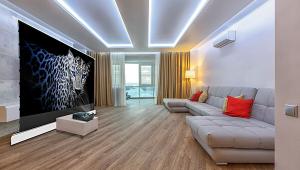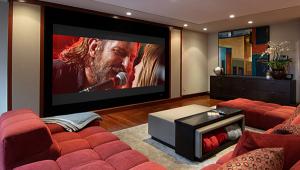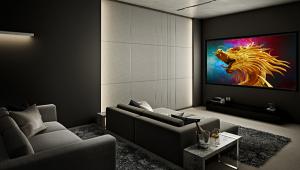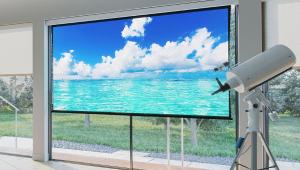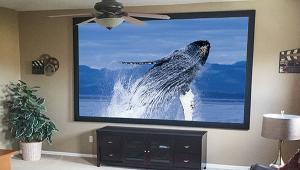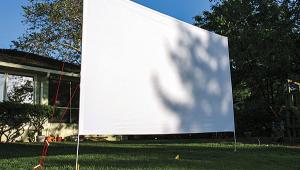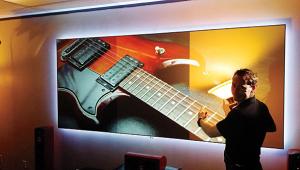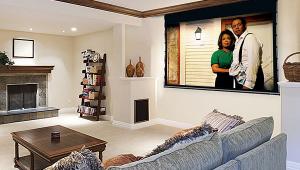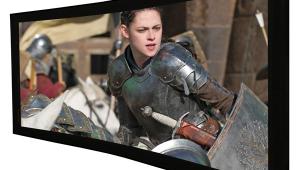Screen Innovations Solo Pro 2 Motorized Projection Screen Review Page 2
Daytime Viewing
My first test of the Slate 1.2 installed within the Solo Pro 2 occurred during a 5 a.m. Sunday West Coast start time to the Formula 1 Austrian Grand Prix. The circuit's crystal clear, snow-dotted Styrian Alpine backdrop was displayed crisply, punching through the less than, ahem, crystal clear urban Los Angeles dawn as strings of light trickled through the slats of my horizontal blinds. As morning progressed, I allowed the room to attain a reasonable daytime illumination level that would be sufficient for ALR evaluation purposes, but with no light landing directly upon the screen surface.
Using my reference three- chip DLP projector (though of beastly footprint, it's a 1080p-resolution machine), my first observation involved the extent to which the Slate 1.2 material slightly tamped down the projector's light output. Though the effect wasn't overt, it nonetheless seized my attention given the screen's gain rating. This projector is capable of delivering plenty of lumens on my much larger reference screen (which is not ALR), so it was interesting to find that the image appeared somewhat muted on the significantly smaller Slate 1.2 material. I don't recall other ALR screens I've reviewed conveying a similar first or even long-term impression. On balance, I can make the point that given the calculated, elevated light level, the Slate 1.2's excellent color saturation brought out the magnificent reds of F1 vehicles when watching the Grand Prix. Contrast held up fairly well, easily conveying the deep, dominating presence of the massive black Pirelli tires that anchored the four corners of each car. While video purists may miss the intrinsic dark detail that unavoidably washes out in a less-than-ideal projection environment, the image with the Slate 1.2 material proved eminently watchable and didn't detract from my interest in the race.
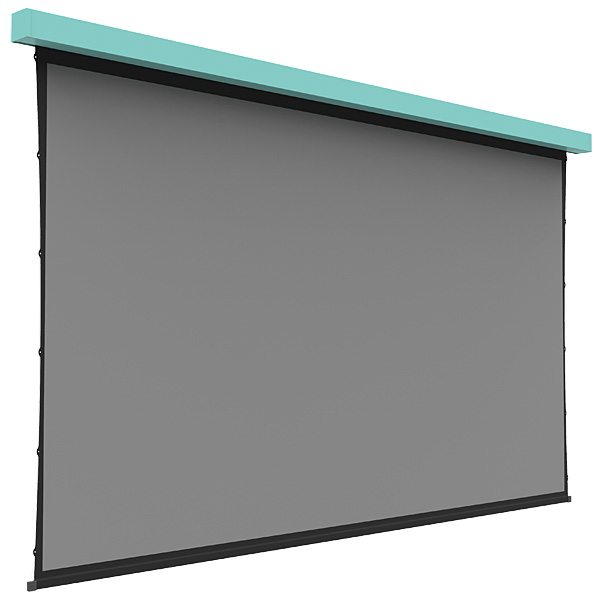
I next watched a battery of Sunday news programs and noted that Slate 1.2 appropriately rendered the complex, diverse skin tones of the hosts and panelists. Bottom line: with content such as outdoor sporting events or shows shot in well-lit studio settings, there would be no lamenting your flat- panel TV if a reverse-roll, Solo Pro 2 in a substantially larger size descended in front of it.
To view a sampling of more critical content, I placed an Ultra HD disc of Bohemian Rhapsody into my Oppo UDP-205 player (set for 1080p output to match the resolution of my projector) and purposely sought out a dimly lit interior sequence and exterior night scene to test the Solo Pro 2/Slate 1.2's ability to handle challenging material. Such scenes revealed a fair degree of contrast suppression; while the image was watchable, any emotional impact was largely siphoned away. In fairness to Screen Innovations, dark movie scenes viewed on any other ALR screen would likely suffer the same fate.
Dark Room Viewing
With my room theatrically darkened, I returned to Bohemian Rhapsody, and, as anticipated, Slate 1.2 provided excellent performance. Consistent with Slate 1.2's specified 70 degrees viewing cone (35 degrees each side of perpendicular), the best result was attained on-axis. Shadow details such as the cascading black locks of guitarist Brian May (played by Gwilym Lee) that were difficult to ascertain in elevated light could now be seen in abundance from my "sweet spot." I did find that the image could look slightly brighter when viewed at moderate angles, but this was attributable to the screen's light- rejecting properties working their wizardry.

As mentioned above, the Solo Pro 2's tensioning system created a slight "curling" effect at the screen's vertical edges. This resulted in a half-inch- wide band near each edge that appeared slightly brighter than the rest of the screen area on content with a normal to enhanced brightness range. As is, it may escape notice by casual viewers, though fussy viewers will find it to be a distraction. Nothing in the Solo Pro 2's owner's manual addresses adjusting the tensioning, nor would it be advisable due to the implications that improper settings might have for smooth screen lowering and retraction. It's possible that over time the screen edges would settle in and fly fully flat, thus eliminating the issue, though that did not occur during my review of the Solo Pro 2.
Conclusion
With its chic, stylish cassette, the Screen Innovations Solo Pro 2/Slate 1.2 combination delights the eyes. When viewing in high ambient light viewing conditions, the Slate 1.2 screen material's satisfying image presentation confirms that it lives up to SI's design objective to free projectors from imprisonment in completely dark rooms. Showcased in more theater-like conditions, it delivers performance on par with the best ALR screens currently available. Add in the battery powered option, and the portable possibilities such as poolside, campground, and tailgating offered by SI's Solo Pro 2 become seemingly endless.
